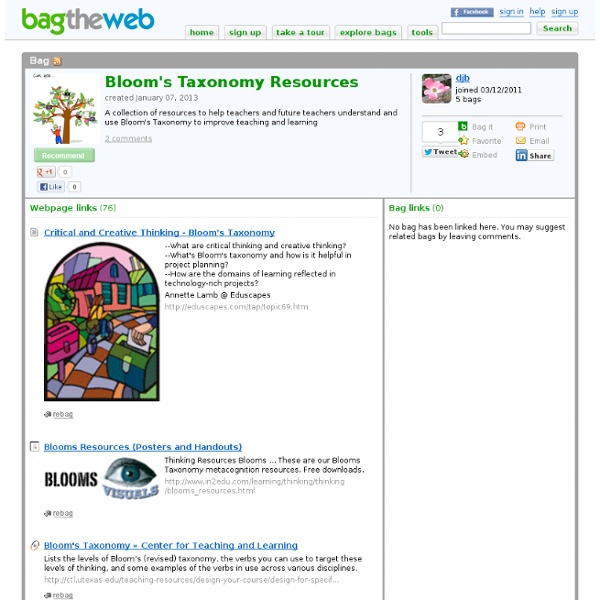Bloom's Taxonomy Resources
Bloom’s Taxonomy can be a powerful tool to transform teaching and learning. By design, it focuses attention away from content and instruction, and instead emphasizes the “cognitive events” in the mind of a child. And this is no small change. For decades, education reform has been focused on curriculum, assessment, instruction, and more recently standards, and data, with these efforts only bleeding over into how students think briefly, and by chance. This stands in contrast to the characteristics of the early 21st century, which include persistent connectivity, dynamic media forms, information-rich (digital and non-digital) environments, and an emphasis on visibility for pretty much everything. What does this mean for how you use Bloom’s Taxonomy in your classroom?
The Best Resources For Helping Teachers Use Bloom’s Taxonomy In The Classroom
Bloom’s & SOLO ‘are not Just Colorful Posters we Hang on the Wall’ is my two-part series at Education Week Teacher. Bloom’s Taxonomy is talked about a lot in educational circles. However, if you believe a recent survey of visits to 23,000 U.S. classrooms, the higher-order thinking skills it’s ideally designed to promote doesn’t get much use. And I can understand why. It’s easy to get caught-up in the day-to-day work involved in teaching a class or multiple classes, and it’s easy to fall into the trap of doing the “usual stuff” and not “think out of the box.” I thought it might be useful to share in a “The Best…” list the resources that help me try to use Bloom’s Taxonomy in my classroom. There may very well be resources out there that do a far better job of explaining the Taxonomy and how to use it. I personally try to use Bloom’s Taxonomy in two ways. In addition, I try to use Bloom’s to help me formulate my own lessons. Bloom’s Revised Taxonomy Memory Understanding Applying and Analyzing
Tips for Writing Instructional Objectives - Bloom's Taxonomy Job Aids
I am so delighted to see this post that includes Bloom's Taxonomy Wheels by ZaidLearn. I always find that it's far easier to design materials using these wheels than it is to see the verbs/products in lists. Many instructional designers can benefit from these job aids when trying to find the right action verbs for their objectives. Here are some wheels for the cognitive domain. Source: Source: Source: Bloom’s digital taxonomy. Have fun, designers!
Bloom's taxonomy
Bloom's wheel, according to the Bloom's verbs and matching assessment types. The verbs are intended to be feasible and measurable. Bloom's taxonomy is a classification of learning objectives within education. It is named for Benjamin Bloom, who chaired the committee of educators that devised the taxonomy, and who also edited the first volume of the standard text, Taxonomy of Educational Objectives: The Classification of Educational Goals. Bloom's taxonomy refers to a classification of the different objectives that educators set for students (learning objectives). Bloom's taxonomy is considered to be a foundational and essential element within the education community. History[edit] Although named after Bloom, the publication of Taxonomy of Educational Objectives followed a series of conferences from 1949 to 1953, which were designed to improve communication between educators on the design of curricula and examinations. Cognitive[edit] Knowledge[edit] Comprehension[edit] Application[edit]
6 Ed Tech Tools to Try in 201 6
About a year ago, I published an e-book called the Teacher’s Guide to Tech. Over the last month, I have been updating it for 2016, adding over 30 new tools and refreshing the information I had about the original ones. I have to say, the 2015 version was excellent, but now it’s SO MUCH BETTER. (To take a peek at the guide, scroll to the bottom of this post.) In the process, I discovered some tools that I absolutely fell in love with, and I wanted to share them with you here. Let’s take a look. Listen to this post as a podcast: Podcast: Play in new window | Download (Duration: 34:24 — 47.6MB) Subscribe: iTunes | Android | One key to improving student writing is to have students write more often. Students browse through a growing collection of writing ideas, each one paired with a visually compelling image, and write about them.Finished posts can then be shared with just one class or made publicly viewable (see examples). Here’s a closer look at Write About: *Amazon Affiliate link.
The Difference Between Pedagogy, Andragogy, And Heutagogy
The Difference Between Pedagogy, Andragogy, And Heutagogy by Terry Heick Jackie Gerstein’s passionate thinking about learning is some of my favorite to read. She is rarely pulled down by trend or fad, but is unquestionably progressive and forward-thinking in her approaches to learning and thinking about learning. She and I also share a passion: self-directed learning. I’m embarrassingly interested in any kind of learning at all–formal or informal, self-directed or teacher-centered, authentic or academic. Gerstein’s presentation, “Education 3.0 and the Pedagogy of Mobile Learning” uses the concept of mobile learning as a spearhead into a broader discussion of how people learn–different approaches, different domains, and different technologies.
Related:
Related:



